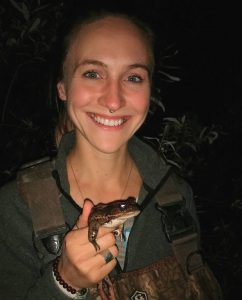Share this article
TWS salutes women in wildlife biology careers: Holley Kline
The National Women’s History Project, founded in 1980, is a nonprofit educational organization committed to recognizing and celebrating women’s diverse and significant historical accomplishments. Each March, the group highlights the accomplishments of women in all professions. This year’s theme is “Nevertheless She Persisted: Honoring Women Who Fight All Forms of Discrimination Against Women.”
In cooperation with the U.S. Fish and Wildlife Service, TWS is pleased to highlight the contributions of women in wildlife conservation and management in the agency’s Women in Science series.
Fish and Wildlife Office Biologist Holley Kline grew up with an interest in animals and outdoors like many children, but she was inspired to pursue a career in wildlife conservation because of an experience she had overseas. That inspiration and passion still motivate her today as she works with partners to achieve a win-win for development and infrastructure needed throughout the San Joaquin Valley and the threatened and endangered species the Endangered Species Act protects. With a little over a year of experience working as a biologist, Holley offers some very practical and impactful advice to those interested in pursuing a career in biology that others often overlook.
Why did you become a biologist?
I grew up loving the outdoors with an interest in animals of every kind but had a really shallow idea of what opportunities were available career-wise. As a result, I tested out a wide variety of biology-related jobs in undergrad and developed an affinity for wildlife conservation. What sealed the deal for me was a study abroad program in Tanzania where I was blown away by the biodiversity and the locals’ perspectives and conservation practices.
What aspect of wildlife biology are you most passionate about?
I’m particularly curious about the complexity of human-wildlife dynamics. People depend upon wildlife as indicators and regulators of healthy ecosystems, as well as for subsistence for many cultures. Equally as important, human activities affect the way wildlife move and use resources on a landscape. It amazes me how these interactions can have a cascading effect and that we keep discovering new levels and paths in which these interactions work.
What do you find most challenging about your work?
Finding balance between the needs of people and those of endangered and threatened species can be difficult. As long as we continue to need more resources, we will continue to expand into undeveloped lands, which can sometimes be the last remaining habitat for these species. It can be challenging to find a happy medium where the project is developed and also maintains the needs of the species so that they can persist. But, the reward of close collaboration and creativity is conservation!
What 3 tips would you give someone in becoming a wildlife biologist?
- Seek out ways to expand opportunities for minorities to become a part of and welcomed into the field. This is particularly important because we work more creatively and effectively as a diversified team.
- Some people will be able to get a long-term job right out of school, and others will do the seasonal/temporary gig for a bit. If you’re one of the former, treat those seasonal/temporary colleagues well – they’re also working hard to get where you are. If you’re one of the latter, you’ll have to manage your money for the off-season, but it can be worth it for the variety of valuable experience in your pocket.
- Don’t be afraid to try new things. A wise mentor encouraged me to try as many new things as I could because, at the very least, I’d better understand my shortcomings and career preferences. I found that advice to be very helpful and will always pass it on.
What are you most hopeful about as it relates to conservation?
As more people enjoy outdoor recreation every year, I think they’re recognizing that they also have a stake in conservation. I am hopeful that will translate into an investment in environmental stewardship so that we have more support to achieve larger conservation goals.
The U.S. Fish & Wildlife Service is a Strategic Partner of The Wildlife Society.
Header Image: Holley Kline is a fish and wildlife biologist in the Sacramento Fish and Wildlife Office's San Joaquin Valley Division. ©Veronica Davison/USFWS









